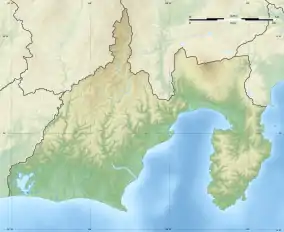Kamishiroiwa ruins
Kamishiroiwa ruins (上白岩遺跡, Kamishiroiwa iseki) is an archaeological site containing the ruins of a late-middle to early-late Jōmon period settlement located in what is now part of the city of Izu, Shizuoka in the Tōkai region of Japan. The site was designated a National Historic Site of Japan in 1978.[1]
上白岩遺跡 | |
 Kamishiroiwa ruins  Kamishiroiwa ruins (Japan) | |
| Location | Izu, Shizuoka, Japan |
|---|---|
| Region | Tōkai region |
| Coordinates | 34°57′48″N 138°59′03″E |
| Type | settlement |
| History | |
| Periods | Jōmon period |
| Site notes | |
| Ownership | National Historic Site |
| Public access | None |
Overview
The site is located 3.5 kilometers from the confluence of the Omi River with the Kamo River and covers approximately 3 hectares. The site contained the foundations of pit dwellings from 3000 to 4000 years ago and an indeterminate number of tombs. Of note were a number of stone circles, one of which was 12 meters in diameter and contained elongated stones in its center which may once have been upright monoliths. Smooth river rocks were mostly used; however, some of the stones in the structure were polished to a flat surface. Outside of the stone circle, some 60 pits were discovered, containing a large number of artifacts, mostly pottery and earthenware. This included a clay token in the form of a human face. Some of these artifacts are now on display at the nearby Nakaizu Historical Museum. The site is open to the public as a park.
References
- "上白岩遺跡" (in Japanese). Agency for Cultural Affairs.
External links
- Izu city official site (in Japanese)
- Izu City Tourist Information site (in Japanese)